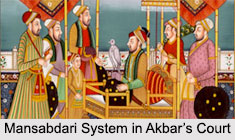 Mansabdar implies the generic term for the military-kind grading of all royal functionaries of the Mughal Empire. The Mansabdars governed the realm and controlled exercise upon its armies in the emperor`s name. Though these men were normally aristocrats, yet, they could not organise a feudal aristocracy, because neither the offices nor the estates that supported them were earned in heredity. The phrase Mansabdari system is derived from `Mansab`, implying rank. Thus, Mansabdar literally stands for a rank-holder.
Mansabdar implies the generic term for the military-kind grading of all royal functionaries of the Mughal Empire. The Mansabdars governed the realm and controlled exercise upon its armies in the emperor`s name. Though these men were normally aristocrats, yet, they could not organise a feudal aristocracy, because neither the offices nor the estates that supported them were earned in heredity. The phrase Mansabdari system is derived from `Mansab`, implying rank. Thus, Mansabdar literally stands for a rank-holder.
Origin of Mansabdari System
Ushered in by the Mughal Emperor Akbar, the Mansabdari system was common to both the military and the civil department. In essence, the Mansabdari system was borrowed from Persia and its inter-country ruling. It was hugely ubiquitous during the reign of Mughal Emperors Babur and Humayun. However, Akbar made some significant changes to the system and made it even more resourceful. Mansabdar was referred to as the official, rank, or the dignity.
History of Mansabdari System
There existed two grades that outlined the Mansabdars. Those Mansabdars whose rank stood in one or two hazari or who was ranked 12,000 or more were named the Omkars. And those Mansabdars whose rank stood below 1000, but not less than 20 were called the Mansabdars. On the whole, these Mansabdars can also be referred to as the Lower Omkars. The ostensible Mansabdari System was originally set up by the Mughal Emperor Akbar approximately in 1575. Unlike feudal elite of the European or Japanese type, Mansabdari was an open, non-hereditary order, casting talented administrators and commanders from India, Iran and Turan. During long periods, the system absorbed some 80 per cent of the empire`s land revenue and in return it recruited and maintained armies in the Mughal service. And these were, according to the umpteen rules of personnel and administrative system of great sophistication, the best cavalry to be had in a vast area.
Merits of Mansabdari System
The Mansabdari system proved helpful in removing the defects inherent in the Jagirdari system. With Mansabdars receiving salaries from the emperor, they were more loyal and chances of their revolt were minimised. And by regulating the maintenance of the horses and horsemen, military efficiency increased. Extra revenue was added to the state, the entire land became state-land and officials realised the revenue drawn from it. Initially the system was not hereditary; a mansab was given to an official on the basis of merit and could be enhanced or lowered. But eventually it did become hereditary.
Demerits of Mansabdari System
There were few demerits of this system like the Mansabdars got their salaries from the emperor and paid salaries to their troops by themselves. This made the troops more loyal to the Mansabdars than to the king. The System proved very expensive due to the high salaries paid to the Mansabadars. There were also the evils of the caste system due to which there was prevalence of discrimination.
Recruitment and Promotion of Mansabdars
The Mansabdars were generalised on the basis of the Zat and Sawar Rank. The Zat pertained to the number of troops maintained by the Mansabdar and the Sawar referred to the number of horses maintained by the Mansabdar.
The category can be listed as below:
No. of Sawar = No. of Zat ` 1st Class Mansabdar
No. of Sawar = 1/2 the No. of Zat ` 2nd Class Mansabdar
No. of Sawar < 1/2 the No. of Zat ` 3rd Class Mansabdar
A Mansabdar had to render service for the state and was obligated to deliver service whenever asked. In addition, they were ranked on the number of armed cavalrymen, or sowars, which each had to maintain for service in the imperial army. Thus all Mansabdars had a zat, or personal ranking and a sowar, or a troop ranking. All servants of the empire, whether in the civil or military departments were ranked in this ubiquitous Mansabdari System. There existed 33 grades of Mansabdars ranging from `commanders of 10` to `commanders of 10,000`. Till halfway of Akbar`s reign, the highest rank an ordinary officer could hold was that of a commander of 5000; the more rarefied ranks between commanders of 7000 and 10,000 were reserved for the royal household. During the period following the reign of Akbar, the ranks were increased up to 20,000 or even more.
Remuneration of Mansabdars
The senior Mansabdars were awarded a jagir (personal fief) instead of a salary. Rates of salary, which included both the Mansabdar`s salary and so much per sowar, were matched by jagirs affording a similar total pay. If their specified yield added up to more, the surplus was hoarded onto the imperial treasury; if the jagirdar could extract more than the specified yield, he kept it for himself.
The emperor had sole and exclusive rights to appoint, promote, suspend or dismiss any Mansabdar. No portion of a Mansabdar`s property was considered hereditary; a Mansabdar`s children had to start his life in his own way. A Mansabdar did not always however begin at the rank; the emperor, if gratified, could and actually did award higher or even rank to any person. There were made no differentiation between civil and military departments; both civil and military officers held Mansabs and were liable to be transferred from one branch of the administration to another. Each Mansabdar was required to hold an ordained number of horses, elephants, equipment, etc., based upon his rank and dignity. These rules, though initially strictly enforced, were later relaxed.



















